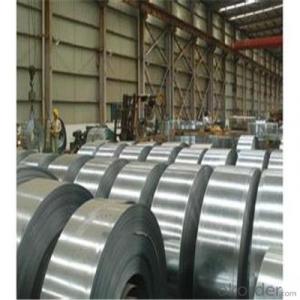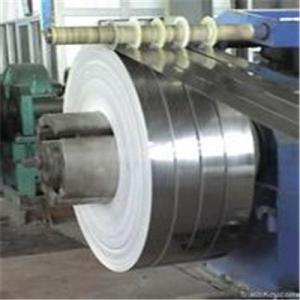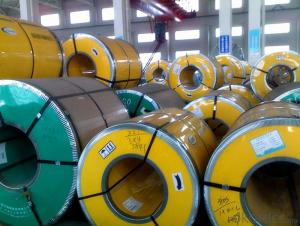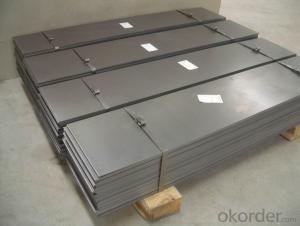Galvanized Steel Strip Coils DX51D in China
- Loading Port:
- Tianjin
- Payment Terms:
- TT OR LC
- Min Order Qty:
- 55 m.t.
- Supply Capability:
- 22232332 m.t./month
OKorder Service Pledge
OKorder Financial Service
You Might Also Like
Item specifice
Applications of Steel Strip Coils:
1:Chemical industry equipment, Industrial tanks
2:Medical Instruments,Tableware, Kitchen utensil,kitchen ware
Festures of Steel Strip Coils:
1. Each coil is closely covered by oil paper or plastic film.
2. Outside it is firmly packed with sack cloth or compound paper.
3. Steel strap or PP strap to pack the outside to ensure safety.
Specifications of Steel Strip Coils:
| Standard | Galvanized Steel Coil Grade | Zinc Coating | Width | Thickness | Length | Capacity/Year |
| JIS G3302 | SGCH/SGCC-SGC570/SGHC-SGH340 | Z40-275g | 30-914mm | 0.3-4.0mm | Coil | 1,00,000Ton |
| EN 10346 | DX51D+Z/DX53D+Z/S220GD-S550GD | Z40-275g | 30-914mm | 0.3-4.0mm | Coil | 1,00,000Ton |
| ASTM A653 | CS-B/SS255-550 | Z40-275g | 30-914mm | 0.3-4.0mm | Coil | 1,00,000Ton |
Images of Steel Strip Coils:
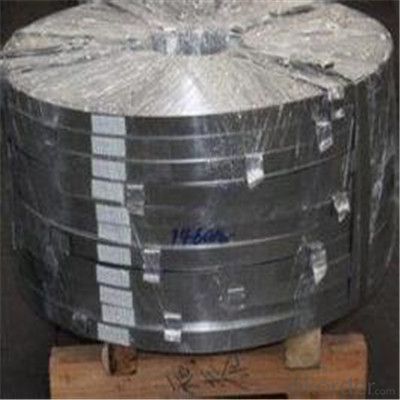
FAQ
1.What's your MOQ?
25MT, it is for one container.
2.Do you have QC teams?
Yeah, sure, our QC team is very important, they will keep the quality control for our products.
3. What's your normal delivery time?
Our delivery time about 10-20days for standard sizes, if you have other requirements like hardness and width ,it is about 20-40days.
- Q:What is the length tolerance of steel strips?
- The length tolerance of steel strips varies depending on the specific industry and application requirements, and it is typically specified by the manufacturer or customer. They indicate the permissible range of deviation from the desired or nominal length, usually expressed as a plus or minus value. For instance, a length tolerance of +/- 0.5mm means the steel strip length can deviate by up to 0.5mm in either direction. Several factors influence the specific length tolerance, including the manufacturing process, intended use, and industry standards or regulations. To determine the appropriate length tolerance, it is crucial to consult the relevant specifications and guidelines provided by the manufacturer or customer. For critical applications like the automotive or aerospace industries, tighter length tolerances may be necessary to ensure precise dimensions. Conversely, less stringent tolerances may be acceptable for applications where exact length is not as crucial, such as construction or general manufacturing. Ultimately, the specific requirements of the application determine the length tolerance of steel strips. Careful consideration is necessary to ensure the strips meet the desired specifications and performance criteria.
- Q:What is a steel strip?
- A steel strip is a flat and thin piece of steel that is typically produced through a process called hot rolling or cold rolling. It is formed by passing a heated or cooled steel billet through a series of rollers, which gradually reduce its thickness and shape it into a long and narrow strip. Steel strips are commonly used in various industrial applications due to their strength, durability, and versatility. They can be found in products such as automotive parts, construction materials, electrical appliances, and packaging materials. The strip's width can vary based on its intended use, and it can also be further processed or treated to enhance certain properties or achieve specific characteristics, such as surface finish, hardness, or corrosion resistance. Overall, steel strips are essential components in many manufacturing processes and play a crucial role in numerous industries.
- Q:What is the maximum width of steel strips?
- The maximum width of steel strips has the potential to fluctuate based on various factors, including the manufacturing process and the capabilities of the equipment utilized. Nevertheless, in broad terms, the width of steel strips can span from a few inches to numerous feet. The precise measurements shall be contingent upon the particular demands of the industry or application in which the steel strips are employed.
- Q:Are steel strips used in the aerospace industry?
- Steel strips are a common material in the aerospace industry due to their versatility and excellent mechanical properties. They find application in various aerospace manufacturing processes, such as constructing aircraft frames, structural components, and wing spars. The use of steel strips enhances the strength and rigidity of aerospace vehicles, ensuring their structural integrity and safety. Moreover, these strips exhibit remarkable resistance to corrosion and temperature fluctuations, making them suitable for extreme environmental conditions encountered in the aerospace industry. Thus, steel strips are crucial in aerospace manufacturing, widely recognized for their durability, strength, and reliability.
- Q:How are steel strips used in manufacturing?
- The manufacturing industry widely utilizes steel strips for various purposes. One particular application involves using these strips as raw materials to produce metal components and parts. Through processes like stamping, bending, or forming, diverse shapes and sizes of metal parts can be created. The automotive industry also heavily relies on steel strips for manufacturing purposes. These strips are utilized to produce parts such as car body panels, brackets, and reinforcements. Their strength, durability, and resistance to corrosion make them perfect for enduring the demanding conditions in automotive applications. Furthermore, steel strips have extensive usage in the production of appliances, machinery, and equipment. Gears, springs, valves, and connectors are among the components manufactured using these strips. The adaptability of steel strips enables the creation of precise and intricate parts that meet the specific requirements of different industries. Additionally, the construction industry incorporates steel strips in its operations. Structural components like beams, columns, and reinforcement bars are manufactured using these strips. With their high strength and load-bearing capacity, these strips are essential for constructing buildings, bridges, and other infrastructure projects. Moreover, steel strips find applications in the production of electrical and electronic devices. Components such as transformers, generators, and electrical panels are manufactured using these strips. The magnetic properties of certain steel alloys make them suitable for these applications. In conclusion, steel strips play a vital role in the manufacturing industry. They possess versatility, strength, and durability, making them suitable for a wide range of applications. From automotive and construction to appliances and electronics, steel strips are indispensable in the production of various components and parts.
- Q:What does "strip 50" mean?
- Medium carbon high strength carbon steel, after quenching with high strength and hardness of the steel cutting medium, cold plastic deformation, poor welding, heat treatment when no temper brittleness, but the hardenability is low, the critical diameter of water is 13*30mm, and when the water quenching cracking tendency. This steel is usually used after normalizing or quenching, tempering, or high frequency surface hardening.
- Q:What are the common surface finishes for carbon steel strips?
- Some common surface finishes for carbon steel strips include mill finish, hot-dip galvanized, electro-galvanized, and painted coatings.
- Q:Are steel strips expensive?
- Yes, steel strips can be expensive depending on various factors such as the type of steel, thickness, length, and market demand.
- Q:Can steel strips be used for making electronic enclosures?
- Yes, steel strips can be used for making electronic enclosures. Steel strips provide strength, durability, and electromagnetic shielding properties, making them suitable for protecting electronic components from external factors such as impact, moisture, and electromagnetic interference. Additionally, steel strips can be easily fabricated and customized to meet specific enclosure requirements.
- Q:What is the hardness of steel strips?
- The hardness of steel strips may differ based on the specific type and grade of steel used. Steel strips are commonly produced using different steel alloys, including carbon steel, stainless steel, or tool steel, each having its own unique hardness properties. The hardness of steel is often evaluated using the Rockwell hardness scale, which assigns a numerical value to measure the material's resistance to indentation or penetration. The hardness of steel strips can range from relatively soft (low hardness) to extremely hard (high hardness), contingent upon factors like alloy composition, heat treatment, and manufacturing processes employed. To determine the specific hardness rating for a particular steel strip, it is necessary to refer to the specifications or data provided by the manufacturer.
1. Manufacturer Overview |
|
|---|---|
| Location | |
| Year Established | |
| Annual Output Value | |
| Main Markets | |
| Company Certifications | |
2. Manufacturer Certificates |
|
|---|---|
| a) Certification Name | |
| Range | |
| Reference | |
| Validity Period | |
3. Manufacturer Capability |
|
|---|---|
| a)Trade Capacity | |
| Nearest Port | |
| Export Percentage | |
| No.of Employees in Trade Department | |
| Language Spoken: | |
| b)Factory Information | |
| Factory Size: | |
| No. of Production Lines | |
| Contract Manufacturing | |
| Product Price Range | |
Send your message to us
Galvanized Steel Strip Coils DX51D in China
- Loading Port:
- Tianjin
- Payment Terms:
- TT OR LC
- Min Order Qty:
- 55 m.t.
- Supply Capability:
- 22232332 m.t./month
OKorder Service Pledge
OKorder Financial Service
Similar products
New products
Hot products
Related keywords
